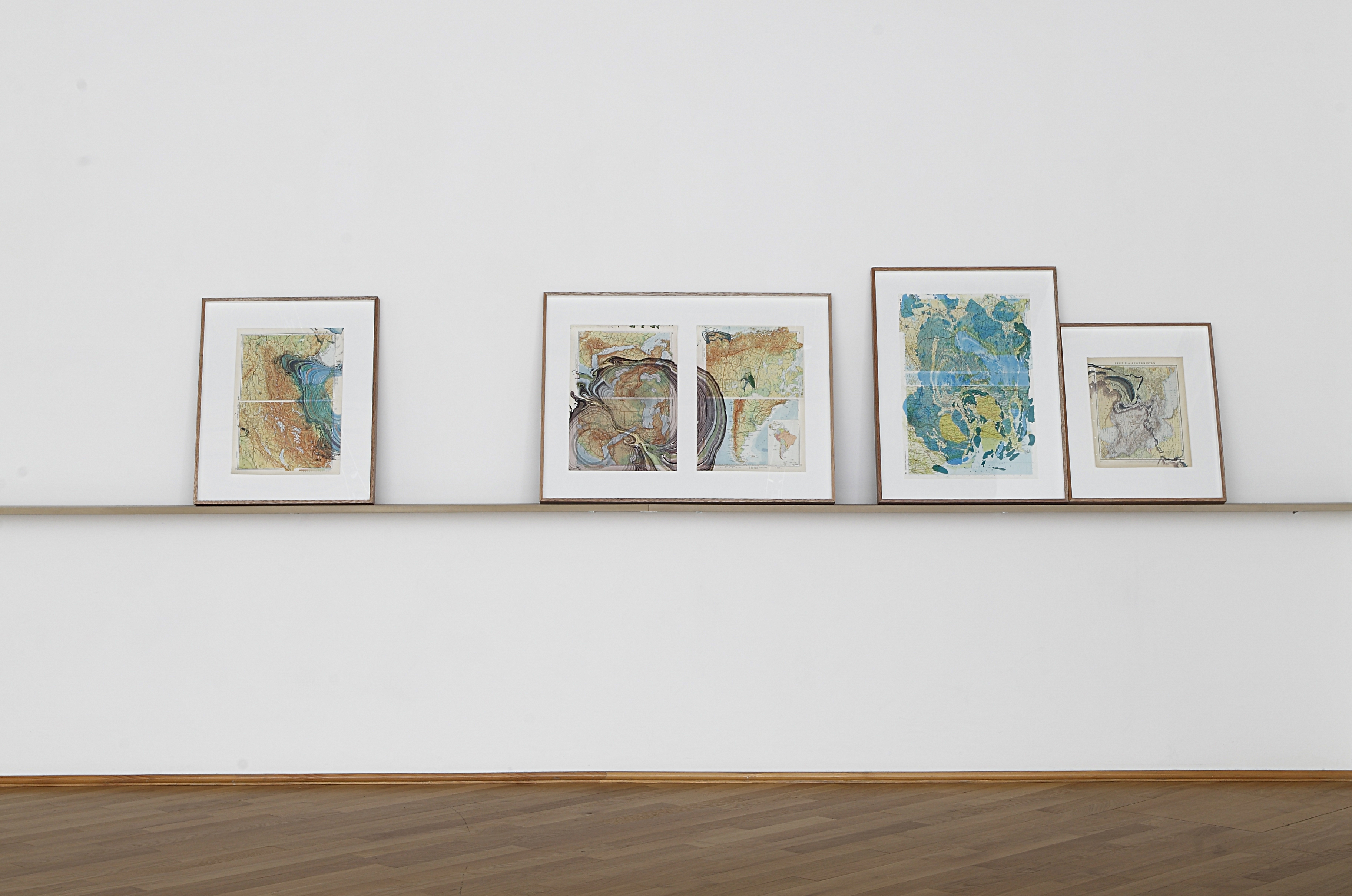︎ ︎︎
Suminagashi (Atlas), 2009-10Suminagashi on atlas, frame
Series of prints on Atlas sheets using Suminagashi, the ancient Japanese printing technique of laying inks on water, also known as marbled paper.
“For Suminagashi (Atlas) (2009-10), the artist collects a multiplicity of cartographic maps of different countries – published in different eras – in order to subject them to a process of transmuting by means of an artistic technique from Japan known as Suminagashi. The mono-printing of a coloured surface over the maps disseminates a new code of interpretation by distorting the power of representation as instructed by the cartographic canon. Precise geopolitical forms drift towards imaginary and unpredictable dimensions, within a concentric expansion where established cartographic reason is dissolved, with its dissolution shown as a clear process that can be observed by the spectator within the winding lines of ink as drawn in the Suminagashi technique. Thus, the dimension of scientific knowledge as represented by the maps is placed in question by the intervention of a philosophical epochè, i.e. an interruption of their accustomed epistemological function, of undetermined duration. Latitude, longitude and cartographic coordinates are constrained by the ink, overlapping to a differential black-out. This is also a gaining of time, where the maps are conveyed towards an indeterminate status which is destined to endure and is thus a symbol of irreversible discomfort. The identitarian equation between the geographic map and world, as has been elaborated over centuries by modern European culture, is hereby smashed within the work Atlas into forms of abstract drawings, almost free vortexes, that are able by virtue of their own their downdraft to annihilate every logical and predetermined constriction. The exit of this process is presented by Schwaighofer within the aesthetically classical dimension of geographic maps, as framed works, as if he wished to conduct the cognitive contortion towards a degree of zero. In this way the work displays a silent, concealed and petrified rhythm, consigned to the interpretative capacity of the spectators.”
Luigi Fassi, in ar/ge kunst #14, Pascal Schwaighofer/Misha Stroj, Mousse Publishing, 2012
Series of prints on Atlas sheets using Suminagashi, the ancient Japanese printing technique of laying inks on water, also known as marbled paper.
“For Suminagashi (Atlas) (2009-10), the artist collects a multiplicity of cartographic maps of different countries – published in different eras – in order to subject them to a process of transmuting by means of an artistic technique from Japan known as Suminagashi. The mono-printing of a coloured surface over the maps disseminates a new code of interpretation by distorting the power of representation as instructed by the cartographic canon. Precise geopolitical forms drift towards imaginary and unpredictable dimensions, within a concentric expansion where established cartographic reason is dissolved, with its dissolution shown as a clear process that can be observed by the spectator within the winding lines of ink as drawn in the Suminagashi technique. Thus, the dimension of scientific knowledge as represented by the maps is placed in question by the intervention of a philosophical epochè, i.e. an interruption of their accustomed epistemological function, of undetermined duration. Latitude, longitude and cartographic coordinates are constrained by the ink, overlapping to a differential black-out. This is also a gaining of time, where the maps are conveyed towards an indeterminate status which is destined to endure and is thus a symbol of irreversible discomfort. The identitarian equation between the geographic map and world, as has been elaborated over centuries by modern European culture, is hereby smashed within the work Atlas into forms of abstract drawings, almost free vortexes, that are able by virtue of their own their downdraft to annihilate every logical and predetermined constriction. The exit of this process is presented by Schwaighofer within the aesthetically classical dimension of geographic maps, as framed works, as if he wished to conduct the cognitive contortion towards a degree of zero. In this way the work displays a silent, concealed and petrified rhythm, consigned to the interpretative capacity of the spectators.”
Luigi Fassi, in ar/ge kunst #14, Pascal Schwaighofer/Misha Stroj, Mousse Publishing, 2012


